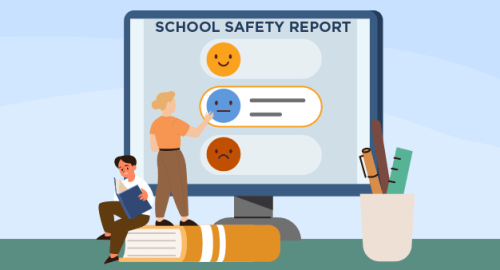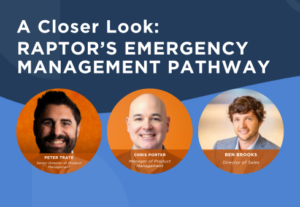Listen to this blog
8 minutes
Findings Reveal Students Concerned with Physical & Emotional Safety at School
A new report released by Safe & Sound Schools, in partnership with Raptor Technologies and Lightspeed Systems, reveals school safety opinions from students, educators, parents, and public safety professionals. The survey reveals that in general, most groups feel schools are safe. However, it also identifies meaningful gaps between stakeholders’ perceptions.
Recently, Raptor held a webinar unpacking the findings of the 2022 State of School Safety Report. The panel was facilitated by Michele Gay, the co-founder of Safe & Sound Schools, who lost her daughter in the 2012 Sandy Hook school shooting. Here is what Gay and our panelists make of the data from this year’s report.
Key Findings: Emergency Management & Response
All students deserve to feel physically safe at school. The 2022 State of School Safety Report reveals that public safety professionals feel they can do more to safeguard students in the event of an emergency.
Emergency Preparedness & Reunification
The vast majority of stakeholders say that their school districts hold a “variety” of school safety drills. Even so, districts are thinking about how they can refresh emergency preparedness drills to better prepare and engage students.
According to Zachary Pope, Director of Safety, Security, Risk, & Emergency Management for Arlington Public Schools in Virginia, one way schools are doing this is by holding “Stop & Think” drills. During these drills, students are asked to pause what they are doing and assess their options for staying safe, should an emergency occur right now.
But while schools are enhancing their emergency preparedness drills, there is an ongoing need for better communication between parents, educators, and public safety professionals about protocol – especially when it comes to reunification.
In the survey, 76% of parents said their schools know how to reunite families in the event of an emergency, yet only 36% of public safety professionals agreed.
Pope says that “parents are having … active conversations with their children at age-appropriate levels” about reunification, but that this information is not being communicated effectively to public safety professionals.
Brenna Morse, former Senior Director of the Tennessee School Safety Center, says she believes the disparity between public safety professionals and school districts originates from public safety professionals’ lack of confidence in their ability to execute the reunification plans established by the district.
Districts can tighten their reunification plan by utilizing technology such as Raptor. As Paul Timm, Vice President of Physical Security Services, attests, “Raptor has done some really great work around reunification” with its School Reunification Software.
School Shootings & Behavioral Threat Assessment
While the 2022 State of School Safety Report reveals many differences in opinion between stakeholders, all groups agree that school shootings are a top safety concern. Significantly, the survey was conducted prior to the most recent mass event in Uvalde, Texas; current concerns may be much higher.
An essential component of preventing tragedies such as those that occurred at Sandy Hook and Uvalde is Behavioral Threat Assessment (BTA). Gay defines BTA as the process of identifying students at risk of violent behavior and delivering targeted interventions “to keep individuals on a safe path.”
The 2022 State of School Safety Report found that more parents and students than expected recognize the importance of BTA in keeping their school community safe. Morse says that while parts of threat assessment are still “misunderstood… this data shows that [students & teachers] are open to the conversation” around BTA.
Key Findings: Emotional Safety & Mental Health
In many ways, students’ emotional safety and mental health are just as important, if not more important, than their physical security in the school setting. The 2022 State of School Safety report found that many schools are ill-equipped to meet students’ mental health needs.
Bullying, Cyberbullying, & Sexual Assault
According to the report, more educators than students feel that schools are doing enough to address issues such as bullying and cyberbullying in their district. This finding suggests that students expect more from schools when it comes to bullying prevention.
Gay says that oftentimes, schools only see “the tip of the iceberg” when it comes to bullying, both online and offline. According to Gay, educators often don’t learn that a bullying incident has occurred until the situation has already escalated.
Pope says that the rapid evolution of digital bullying tactics is another major obstacle to schools’ understanding of and response to cyberbullying: “Every time I think that I have caught it, I am five steps behind.”
Similarly, only 54% of students feel their school is doing enough to address the rising incidence of sexual assault, compared with 77% of educators. Pope explains that the disparity may owe to federal Title IX guidelines, which were written to serve the needs of higher education rather than K-12 schools.
The results of this survey may identify a need for more targeted programs to prevent and address sexual assault in grades K-12. As Timm says, “Programs aren’t enough. People are what’s going to determine [what’s effective] in the end.”
Mental Health
The vast majority of educators and public safety professionals have identified a growth in the number of students facing depression and anxiety. Even so, perhaps the most alarming finding of the 2022 State of School Safety Report was the discovery that schools are not doing enough to address students’ mental health needs.
Pope says, “One of the things that is telling about this [finding] is that .. our students are the ones saying that we are underprepared to address their mental health needs.” While 83% of educators believe their schools are equipped to address a mental health crisis, only 61% of students agree – suggesting that students are feeling the ongoing shortage in school mental health professionals.
Gay identifies a significant gap between the number of school psychologists, counselors, and social workers and the growing number of students in need of mental health support. However, as Morse says, capturing this data will become increasingly important in helping schools access resources, allowing them to hire more mental health professionals and explore other student wellbeing options to support students’ needs.
“That’s the power of asking,” says Gay. “[Students are] speaking up, and they’re telling us, ‘what’s here isn’t enough.’”
Click here to download the full 2022 State of School Safety report – and to hear more of what students, educators, parents, and public safety professionals are saying about school safety.
Related Resources
Guide to K-12 Student Wellbeing
Strategies to Recognize, Document, and Support Students in Distress.
Learn More
Listen to this blog
8 minutes








